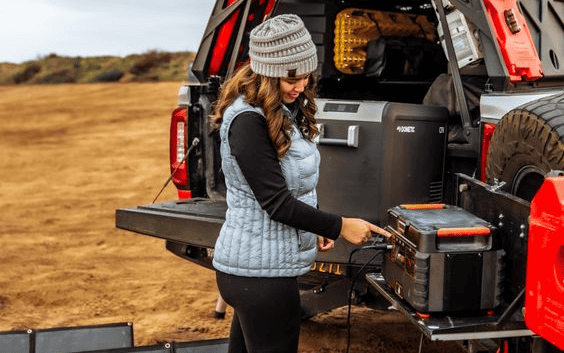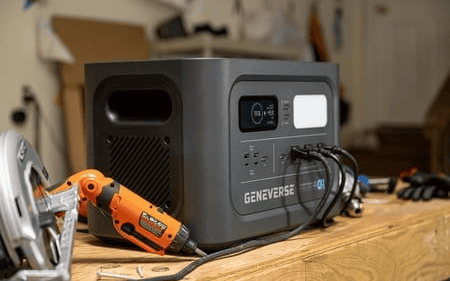Keeping your portable power station in top shape ensures you’re always ready for adventure or emergency. Did you know that proper maintenance can significantly extend the life of your device? This article will guide you step-by-step on how to use and maintain your portable power station safely.
Dive in for expert tips and keep your power supply reliable.
Key Takeaways
- Choose a portable power station that matches your energy needs and ensure it has safety certifications like UL or CE.
- Regularly charge and use the power station, following manufacturer guidelines to avoid battery damage and maintain performance.
- Always place the power station in a cool, dry location with good ventilation to prevent overheating and extend its lifespan.
- Check device compatibility before connecting them to your power station to avoid overloading and possible damage.
- Conduct routine inspections on cables, connectors, vents, and batteries; replace any damaged parts promptly for safe operation.
Understanding Your Portable Power Station
When it comes to understanding your portable power station, it’s important to consider the different types available, their key features and specifications, as well as safety certifications.
This will help you make informed decisions about which one is best for your specific needs.
Types of portable power stations
Understanding the different types of portable power stations helps you choose the right one for your energy needs. They come in various sizes and capabilities, designed to meet diverse requirements.
- Battery-Powered Stations: These are the most common type, equipped with rechargeable batteries. You can charge them through a standard wall outlet or solar panels. They’re perfect for camping trips or as emergency power backups.
- Solar-Powered Stations: Built with integrated solar panels, these harness sunlight to generate electricity. They often take longer to charge but are eco-friendly and ideal for outdoor activities where sunshine is abundant.
- Gasoline-Powered Inverters: Unlike traditional power stations, these use gasoline to produce electricity. While not suitable for indoor use due to emissions, they offer more power and are useful in areas without access to electric grids.
- Hybrid Power Stations: Combining battery storage with solar inputs, hybrids offer flexibility. You can charge them from an electrical source or via solar panels, providing a balance between convenience and sustainability.
Key features and specifications

Portable power stations come in various types, including lithium-ion, lead-acid, and solar-powered models. Understanding the key features and specifications is crucial when selecting a suitable option for your energy needs.
Look for safety certifications such as UL or CE to ensure the power station meets industry standards. With battery level monitoring and power management capabilities, you can keep track of the energy supply and optimize usage efficiently.
When choosing a portable power station, consider factors such as the maximum output capacity, number of AC outlets, USB ports, and DC sockets available. This will determine its compatibility with your devices and appliances.
Safety features and certifications
Portable power stations come with various safety features and certifications to ensure their reliability and user safety. Look for models with overcharge protection, short-circuit protection, and temperature control to safeguard both the unit and connected devices.
Additionally, seek out portable power stations that are certified by reputable organizations such as UL (Underwriter Laboratories) or ETL (Intertek) to guarantee compliance with industry standards.
These features and certifications provide peace of mind while using your portable power station.
When shopping for a portable power station, prioritize those equipped with comprehensive safety features like overcharge protection, short-circuit protection, and temperature control.
Furthermore, consider models certified by trusted organizations such as UL (Underwriter Laboratories) or ETL (Intertek), which demonstrate adherence to rigorous industry standards.
Best Practices for Using Your Portable Power Station

Position your portable power station in a well-ventilated area and ensure it is compatible with the devices you plan to use. Be mindful of power draw and consider routine charging practices to prolong its battery life.
Safe placement and ventilation
Position the portable power station in a well-ventilated area to prevent overheating and ensure proper airflow around the unit.
Device compatibility and power draw
To use your portable power station safely and efficiently, it is essential to consider device compatibility and power draw. Here are some essential aspects to keep in mind:
- Ensure that the devices you connect to the power station are compatible with its output specifications to prevent damage or malfunction.
- Check the power draw of each device to avoid overloading the power station and compromising its performance.
Maximizing energy efficiency
To maximize energy efficiency, ensure that your portable power station is charged and used regularly. Keep the battery at around 40% capacity when not in use to minimize capacity loss.
Clean the solar panels frequently to maintain their efficiency, and use the correct charging equipment for safe and efficient charging. By following these practices, you can optimize the energy efficiency of your portable power station for long-term reliability.
– Routine Charging Practices
Routine charging practices
After maximizing energy efficiency, routine charging practices are essential to ensure the longevity and optimal performance of your portable power station. It is important to charge your power station regularly, ideally at least once a month, even if it’s not in use.
Overcharging or undercharging can damage the battery, so using the correct charging equipment and following manufacturer guidelines is crucial. Additionally, storing the power station with a charge level around 40% when not in use can help preserve its capacity.
Ensuring that you follow these practices will help maintain the safety and integrity of your portable power station for long-term usage.
Safety Guidelines for Maintaining a Portable Power Station

Proper setup and positioning of your portable power station is essential to ensure safe operation. Regular inspection and maintenance of components are also important to prevent potential hazards and ensure the longevity of your power station.
Proper setup and positioning
Position your portable power station in a well-ventilated and dry area to ensure optimal performance.
Keeping power stations dry and ventilated
When maintaining your portable power station, it’s vital to ensure that it remains dry and well-ventilated. Here are important tips to keep your power station in prime condition:
- Prevent exposure to moisture or water, as this can damage the components and reduce efficiency over time.
- Store the power station in a cool, dry place, away from direct sunlight and extreme temperature fluctuations.
- Regularly inspect for any signs of moisture or condensation buildup, especially after periods of high humidity or drastic temperature changes.
- Ensure proper ventilation by positioning the power station in an area with adequate airflow to prevent overheating.
- Consider using a dehumidifier or airtight storage container with desiccant to maintain optimal humidity levels during storage.
Avoiding overloading and overheating
To ensure the safe and efficient operation of your portable power station, it is crucial to avoid overloading and overheating. Here are some key guidelines to follow:
- Check the power draw of all devices connected to the power station to prevent overloading and potential damage to the unit’s internal components.
- Ensure proper ventilation around the power station to prevent overheating, especially when operating in enclosed spaces or during warm weather conditions.
- Monitor the temperature of the power station during use and avoid placing it in direct sunlight or near heat sources that could cause overheating.
- Regularly inspect the power station for any signs of overload or overheating, such as unusual noises, excessive heat, or erratic behavior, and take immediate action if any issues arise.
- Consider using a surge protector or an uninterruptible power supply (UPS) to safeguard against sudden spikes in electrical load and protect your devices from potential damage.
- Adhere to the manufacturer’s recommendations for maximum load capacity and operating conditions to ensure safe usage without risking overloading or overheating.
- Implement a routine maintenance schedule that includes checking for any loose connections or damaged components that could contribute to overloading or overheating issues.
Inspecting and replacing components
To ensure the proper functioning and longevity of your portable power station, it’s crucial to inspect and replace components as needed. Here are some important steps to follow:
- Regularly check the condition of cables, plugs, and connectors for any signs of wear or damage. Replace any worn-out components to maintain safe and efficient operation.
- Inspect the battery terminals for corrosion or loose connections. Clean the terminals with a mixture of baking soda and water if necessary, and ensure tight connections to prevent power disruptions.
- Examine the inverter for any visible damage or irregularities in its performance. Replace the inverter if it shows signs of malfunction to avoid electrical hazards.
- Check the overall condition of the power station enclosure for cracks, dents, or exposure to moisture. Replace or repair any damaged parts to protect the internal components from environmental damage.
- Inspect the cooling fans for dust accumulation or unusual noises during operation. Clean the fans regularly to prevent overheating and ensure proper ventilation.
- Monitor the status indicators and controls for any malfunctions or erratic behavior. Replace faulty indicators or controls as needed to maintain accurate monitoring and control of the power station.
Conclusion
Safely using and maintaining your portable power station is crucial for its longevity. Regularly cleaning the solar panels, avoiding overcharging, and inspecting components are essential tasks.
Properly storing it at 40% capacity in a dry place with ventilation will help keep it in top condition during storage. Following these steps and the manufacturer’s guidelines will ensure safe and efficient use of your portable power station.
FAQs
1. What are the key steps for safely using a portable power station?
To use your portable power station safely, always check battery levels before use, ensure you’re using the correct charging equipment, and never overcharge or overdischarge the battery.
2. How should I store my portable power station when not in use?
Store your portable power station in a cool, dry place away from direct sunlight to keep it safe and maintain its lifespan.
3. What maintenance should I perform on my camping power station?
Proper maintenance includes regularly inspecting your power supply unit for damage, cleaning solar panels if applicable, and keeping connections clean to ensure efficient operation.
4. Can I charge my portable power station with any charger?
No, only use the charging equipment recommended by the manufacturer of your solar or battery backup system to avoid damaging it.
5. Why is cleaning important for maintaining my solar-powered charging station?
Keeping solar panels clean ensures they can efficiently convert sunlight into energy for powering up your device; dirt and debris reduce their effectiveness.

